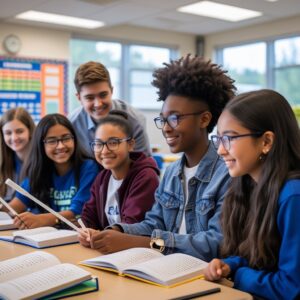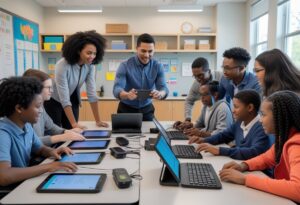Working Together for Visually Impaired Students: Effective Collaboration Strategies for Inclusive Education

Working Together for Visually Impaired Students
How Collaboration Transforms Support for Visually Impaired Students
When teachers, specialists, and families work together, students who are visually impaired gain the support they need to succeed in the classroom and beyond. We see every day how teamwork can help students access information, participate in social activities, and feel included at school.
Our experience at New England Low Vision and Blindness shows that thoughtful planning, communication, and the right tools can make a real difference. By sharing our knowledge and resources, we help teachers of the visually impaired build learning environments where every student has the chance to thrive.
Understanding Visual Impairments in Education
Students with visual impairments each have unique strengths and needs. Understanding the types of vision loss, accurate definitions, and the most common challenges helps us provide better support in school settings.
Types of Visual Impairments
Visual impairments include a range of conditions that affect how students see. Many students have low vision, which means they have trouble seeing even with glasses or contacts. Others might be totally blind, meaning they cannot see any light or shapes.
Common conditions causing vision loss include:
- Congenital blindness: Present at birth
- Acquired blindness: Occurs after birth, often from injury or disease
- Low vision: Partial sight that can’t be corrected fully
Some students may have light perception only, while others might see shapes and colors but lack clear detail. Each student’s experience is different and may change over time.
Definitions of Blindness and Low Vision
Blindness and low vision are two distinct terms. Blindness refers to severe vision loss where little or no usable vision remains, even with the best medical help. Totally blind students often rely on non-visual methods, such as braille, tactile graphics, and audio tools.
Low vision means a student’s vision is reduced and cannot be improved with regular glasses, but they still have some usable sight. Students with low vision may read large print, use magnifiers, or benefit from high-contrast materials. The exact definitions can vary by school, state, or country, but below is a common distinction:
| Type | Description |
| Totally Blind | No usable vision; often relies on touch or sound |
| Low Vision | Some functional sight remains |
Our role is to match support and technology to each student’s specific level of sight.
Common Challenges Faced by Visually Impaired Students
Visually impaired students face challenges that can impact learning, socialization, and independence. They may find it difficult to see reading materials, classroom displays, and facial expressions. Locating objects or people in the classroom or hallway can also be hard.
Some students might struggle with understanding visual cues or spatial relationships. This can affect classroom participation, note-taking, and connecting with peers. Many use leading-edge assistive technology such as screen readers, magnifiers, and braille devices to access information.
Learning to move independently, often with a white cane or using tactile maps, is important for building confidence and safety. Our support as educators and technology trainers helps reduce barriers and promote equal access for blind and low vision students.
Roles and Collaboration Among Support Teams
Supporting students with visual impairments requires the expertise of several team members who each play a clear and vital role. By combining specialized teaching strategies, skills training, and strong teamwork, we help students gain confidence and reach their academic and social goals.
The Role of our Assistive Technology Specialists
Our Assistive Technology Specialists design and deliver individualized instruction tailored for students with visual impairments. We adapt classroom materials, select accessible resources, and teach key skills such as Braille, use of magnification devices, and digital tools. We also offer training on leading-edge assistive technology, making lessons more accessible and engaging.
In close partnership with classroom teachers, our Assistive Technology Specialists adjust teaching strategies to meet each student’s specific needs. They help design lesson plans that address both academic and functional life skills. TVIs assess student progress, share feedback with families, and provide guidance about educational programming and evaluations.
Additionally, TVIs lead in creating accessible learning environments. They ensure all students can participate fully in activities by coordinating with staff to remove barriers to learning and inclusion.
Key Tasks:
- Customize curriculum materials.
- Teach Braille and technology.
- Collaborate with families and educators.
- Monitor and support student progress.
Orientation and Mobility Specialists
The role of the orientation and mobility (O&M) specialists is to teach students practical skills to navigate their surroundings safely and confidently. They provide direct instruction on the use of canes, spatial concepts, and travel techniques for various environments, including school and community settings.
O&M specialists evaluate the unique travel needs of each student, then develop and implement structured lessons. They educate students about personal safety, street crossings, landmark identification, and public transportation use. We encourage hands-on practice in real-life settings to build independence.
These specialists coordinate with TVIs, teachers, and families, ensuring that mobility training aligns with academic and social goals. This team approach allows for continuous support and progress monitoring.
Key O&M Skills Taught:
- Safe street crossing and navigation.
- Effective cane use and mobility tools.
- Problem-solving during travel.
- Orientation to new environments.
Collaboration with Support Staff and Peers
Effective support for visually impaired students depends on strong collaboration among our Assistive Technology Specialists, TVIs, O&M specialists, paraprofessionals, and classroom teachers. Together, we create consistent routines, adapt activities, and provide ongoing encouragement.
We involve families in planning and reviewing goals to ensure learning continues beyond the classroom. Professional staff members, such as occupational therapists and school counselors, offer expertise in areas like daily living skills and social-emotional development.
Peer support also plays a key role. We encourage group projects, peer mentoring, and collaborative classroom activities to foster inclusion, build friendships, and support academic growth.
Ways We Collaborate:
- Regular team meetings to share strategies.
- Open communication with TVI’s and families.
- Peer-assisted learning and group work.
- Coordination with specialists across disciplines.
Inclusive Teaching Strategies for Visually Impaired Students
When working with visually impaired students, it is important to use teaching methods that address their unique needs. We focus on proven strategies, accessible tools, and effective team efforts that help each student take part in classroom learning.
Multi-Sensory Teaching Approaches
We believe teaching is most effective when it uses more than one sense at a time. For students with visual impairments, combining touch, sound, and movement with spoken words makes lessons more engaging.
For example:
- Use audio instructions along with tactile materials
- Incorporate hands-on models and raised-line drawings
- Give verbal descriptions while students use manipulatives like textured shapes
Group projects or labs with tactile, auditory, and kinesthetic components help students understand abstract concepts. By appealing to different senses, we create a richer learning experience and reinforce important ideas.
Accessible Learning Materials and Resources
Accessible materials are essential for visually impaired students. We provide digital textbooks, braille, and large print formats. Using screen readers, magnifiers, and leading-edge assistive technology ensures equal access to information.
A table of useful resources:
| Material Type | Example |
| Braille | Braille textbooks, labels |
| Large Print | Enlarged handouts, worksheets |
| Digital Resources | Screen reader-compatible files |
| Tactile Graphics | Raised-line maps, diagrams |
Adjusting worksheets, providing audio files, and labeling classroom items in both braille and large print supports independence. With the right resources, visually impaired students can work at their own pace and join in classroom activities.
Classroom Communication Best Practices
Clear and direct communication is important when teaching students with visual impairments. We always say students’ names when addressing them and describe visual information aloud. Giving specific verbal instructions helps students follow along.
Announce transitions and describe what is happening in the classroom. For example:
- “We are moving to the left side of the classroom now.”
- “I am handing out red paper for the next activity.”
Checking for understanding, inviting questions, and allowing extra time for responses create a supportive environment. By using precise communication, you can your students participate fully.
Peer Collaboration and Group Activities
Collaboration helps visually impaired students build social skills and feel included. We encourage group work and to structure activities where all students have a role.
To support teamwork:
- Assign peer buddies when needed
- Use group discussions where everyone shares ideas out loud
- Set clear responsibilities for each student
Role cards and verbal instructions allow everyone to know their tasks. Group activities with tactile materials or verbal brainstorming support equal participation. By fostering collaboration, we help students with visual impairments develop confidence and connections with classmates.
Assistive Technologies and Visual Aids in the Classroom
Effective access to education for visually impaired students depends on a range of specialized tools. Each type of technology or resource helps break down barriers and supports meaningful learning.
Braille Textbooks and Materials
Braille textbooks are essential for students who are blind or have severe vision loss. These materials provide equal access to classroom content in a format that students can read with their fingertips.
We support teachers by identifying Braille versions of textbooks, math tools, and even tactile graphics for science and geography. Having access to these materials gives students the ability to work independently, take notes, and follow along with class discussions.
Educators should ensure that students receive up-to-date Braille materials at the same time as their sighted peers. By doing so, we help visually impaired learners fully participate in assignments and group activities.
Screen Readers and Magnification Tools
For students with functional vision or who are blind, technology like screen readers and magnification software can be life-changing. A screen reader reads digital text and image descriptions out loud so students can access websites, e-books, and documents on computers or tablets.
Magnification tools—such as software programs or electronic magnifiers—enlarge text and images, making reading easier for students with low vision. We recommend customizable solutions since each student’s vision is unique.
It’s crucial that schools install and update these tools on classroom devices. Training helps students and staff feel comfortable and confident using all features.
Tactile and Audio Learning Resources
Hands-on learning benefits students who are visually impaired. We offer tactile resources like raised maps, embossed diagrams, and textured math tools so students can explore and understand complex information through touch.
Audio resources add another layer of support. Audiobooks, talking calculators, and audio-based educational apps let students listen to lessons or instructions at their own pace. These tools not only support academic work, they also boost independence.
Combining tactile and audio resources encourages active learning and helps students participate fully in all classroom subjects.
Professional Development and Training for Educators
Effective support for students with visual impairments begins with high-quality, targeted professional development. At New England Low Vision and Blindness, we offer customized training programs that provide educators with the knowledge and confidence to integrate assistive technology, understand the functional impact of various visual impairments, and access valuable resources. Our workshops are tailored to meet the needs of school teams, helping them address IEP requirements, adapt classroom materials, and improve learning outcomes. Delivered on-site or remotely, these sessions are designed to be practical, interactive, and immediately applicable in real-world educational settings.
Learn more https://nelowvision.com/professional-development-workshop/
Training on Visual Impairments and Assistive Technology
We know how vital direct training is for understanding vision loss. Teachers of the Visually Impaired (TVIs) need to learn about different types and degrees of vision impairment. This foundation lets us shape better learning plans for your students.
Assistive technology plays a major part in student success. For instance, teachers learn to use screen readers, magnifiers, and braille devices. These tools help students access books, websites, and classroom materials. We also show how to match technology to each student’s needs.
Our professional development sessions are often hands-on. We focus on:
- Identifying the right tools for each situation
- Setting up devices and software correctly
- Troubleshooting basic tech issues
Training covers both common technologies, like electronic magnifiers, and specialized software. As these tools improve, we stay up-to-date through regular workshops. This ensures that TVIs are prepared for any classroom challenge.
Ongoing Professional Support and Resources
Ongoing support is just as important as initial training. We encourage educators to join professional networks and seek out new resources on a regular basis.
TVIs can participate in online forums, regional workshops, and peer learning groups. These spaces allow us to share questions and solutions quickly. Staying connected helps us remain aware of the most recent teaching strategies for visually impaired students.
We also recommend routine continued education. This might include webinars on updated best practices, guided courses on new assistive software, or attending local conferences focused on low vision topics.
Below is a quick reference table of useful professional resources:
| Resource Type | Examples |
| Online Communities | Professional forums, educator networks |
| Informational Guides | Training manuals, technology quick-starts |
| Workshops & Webinars | Statewide trainings, virtual sessions |
| Local Support Groups | Regional educator meetings |
Having ongoing access to support and resources means we can always provide high-quality instruction that meets the needs of your students.
Frequently Asked Questions
We address the most common concerns when working with visually impaired students. Our goal is to provide clear strategies, helpful resources, and practical advice based on real classroom needs.
What are the best strategies for accommodating visually impaired students in mainstream classrooms?
It is important to start with a thorough understanding of each student’s visual condition, learning style, and specific needs. We recommend meeting with the educational team to review the student’s file and discuss effective accommodations.
Classroom materials should be adapted using large print, high-contrast copies, or braille as needed. Verbal instructions, seating arrangements near the front, and uncluttered workspaces also create a more accessible environment.
Which teaching aids are most effective for students with visual impairments?
Some of the most helpful teaching aids include tactile graphics, braille books, audio books, and digital magnifiers. Leading-edge technology such as screen readers and refreshable braille displays support access to digital content.
Hands-on materials and objects for touch learning can further reinforce concepts. Our assistive technology trainers help educators select and implement the right aids for every unique situation.
What challenges do visually impaired students face in academic environments?
Students with visual impairments often struggle with access to printed materials and visual displays. Social isolation and difficulty navigating physical spaces may also affect their experience.
Routine tasks like taking notes, viewing the board, and participating in group activities can present extra challenges. Timely support and thoughtful planning are necessary to help overcome these barriers.
How can educators effectively collaborate with a Teacher of the Visually Impaired (TVI)?
Open communication is key when working with a TVI. It is helpful to schedule regular check-ins and share observations about the student’s progress.
We suggest inviting the TVI into the classroom to demonstrate adaptive tools and teaching techniques. Collaboration helps everyone on the team understand and address learning needs more effectively.
What support structures are essential for the success of students with visual impairments?
A supportive team includes classroom teachers, the TVI, family members, and specialists who work together in planning and problem-solving. Accessible instructional materials, assistive technology, and consistent peer support are all critical.
Ongoing training for school staff and regular feedback from students help maintain a positive learning environment. Frequent review of accommodations makes sure everyone’s needs continue to be met.
How can technology be integrated to support learning for visually impaired students?
Technology should match the individual needs of each student. Screen readers, digital magnifiers, and accessible tablets are common tools that make a strong impact.
We provide training on the latest solutions, making it easier for students to complete assignments, access digital resources, and communicate with peers. Partnering with assistive technology professionals ensures students receive proper support and equipment.
Download this content as a PDF
Empower Your Classroom with Inclusive Strategies
Are you ready to transform your classroom for students with low vision?
Explore practical training, proven adaptations, and the latest assistive technologies to ensure every student thrives. Whether you’re an educator, school administrator, or support professional, our tailored Education & Training Services equip you with the tools and confidence to create a truly inclusive learning environment.
Learn more and schedule your customized training today:
nelowvision.com/training-services/education-training-services/



